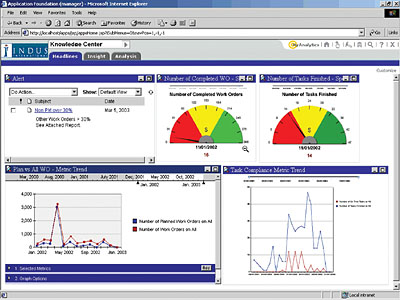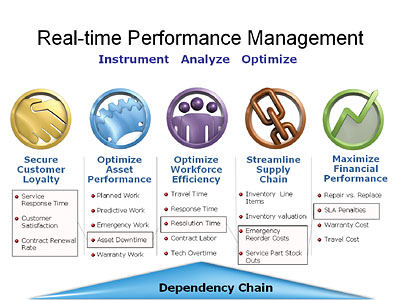"To achieve operational excellence, energy companies must adapt to change and optimize business processes in real time."
— META Group1
Driving Business Value
Energy companies today face increasing pressure to achieve outstanding performance in the delivery of services – and at a lower cost. The ability to meet this challenge hinges on personnel having the right information, at the right time, where the information is needed to make decisions and provide answers. For true operational excellence, however, this information must provide more than just data on what has happened in the past. It must help us understand what is happening as it happens (or even before) so that a more effective job can be done of managing risk and avoiding critical shortfalls in asset availability and customer service. Managing this on-demand information and delivering it to the appropriate points in the workflow to drive business value is defined as Real-Time Performance Management.
Real-Time Performance Management comprises five critical business
areas, which must be successfully addressed to drive true business value and
become a world-class organization.
1. Improve Asset Performance
It is imperative to control and reduce all asset lifecycle costs, as well as budget and plan more accurately. Assets must operate at peak performance to avoid unnecessary downtime and shorten planned outages. This requires that the utility have real-time visibility into the health and condition of facilities, equipment and/or critical parts.
2. Maximize Financial Performance
World-class organizations must have the right tools to analyze and balance the financial impact of strategic and operational initiatives across the organization – and to determine best-case alternatives. Real-time performance management furthers this goal by transitioning organizations from reactive to proactive decision-making in order to optimize performance and maximize financial gain.
3. Optimize Workforce Efficiency
Progressive utilities must operate their workforces at optimum efficiency, addressing planned and unplanned work requests without missing a beat. Instant field communications and feedback is vital. The utility must have real-time visibility into resource availability, skill sets, parts, tools, customer requirements, and documentation.
4. Ensure Customer Loyalty
Customer Loyalty is the most accurate barometer of true world-class performance. Loyal customers are those whose requests have been responded to quickly, whose issues have been resolved promptly, and whose interactions with us have left them desirous of purchasing additional services. To make this a reality, the utility must be able to instantly access and analyze enterprisewide information to rapidly respond to customer requests and make timely and accurate decisions. Accurate billing and collection cycles and precise scheduling, dispatching and optimization of mission-critical resources are required.
5. Streamline the Supply Chain
The supply chain must operate leaner than ever, with better planning and streamlined logistics. Utilities must increase visibility into the availability of spare parts, optimize inventory levels, and cut down on the number of suppliers if they are to deliver the right parts to the right place at the right time, and at the right cost.

The Dependency Chain
While each of these five areas brings its own imperative for business optimization, the essence of Real-Time Performance Management is managing all of these key processes simultaneously. There is a dependency chain of interrelated key performance indicators and their associated activities, which cuts across the organization’s functional silos. Figure 1 shows how an event in one operational segment impacts all other functional areas. Recognizing these cross-functional processes, and taking steps to manage them in light of their interdependencies, is key to achieving world-class performance.

Figure 1
The Real-Time Enterprise
Enabling and managing the matrixed, real-time performance of an organization is challenging, but essential for success. Examining the concept of the “real-time enterprise,” Rick Nicholson, META Group Vice President, emphasized the importance of “the combination of real-time information and business processes,”1 two essential ingredients for Real-Time Performance Management.
The first ingredient seems self-evident. How can you have a real-time enterprise without real-time information? However, “real-time information” is not necessarily defined as instantaneous access to all information as measured by absolute time. It is more accurately defined as having access to the precise information required in the context of a specific business event.
In other words, it is more valuable (and cost-effective) to have the right information delivered to you at the time that you need it than to have continuous immediate access to a wealth of information you don’t need. So, latency is only important when it impacts the accuracy or reliability of a decision, a transaction, or some other interaction point.
This point ties into the second ingredient focused on “business processes,” since the real-time challenges of an organization are found in the upstream and downstream processes leading to a point of interaction. Consider the customer service representative on the phone trying to answer a customer’s question regarding service that is to be performed today. The CSR needs to know whether the technician has been dispatched, if he will arrive on time, and whether he will be able to complete the work once he is there. Similarly, the technician needs to understand the details of the commitment that has been made, the work that is required to be performed, and the supplies and tools that are needed. These business process handoffs
– between segments of the organization and between software applications
– are where the vast majority of real-time challenges lie.
Therefore the key to real-time performance management is not in having immediate access to all information across the organization. They key is having only the information required from each segment and software application at the point where that particular information is needed by another segment or software application to optimize a business process.
Instrument, Analyze, Optimize
Obviously, traditional methods of managing the organization must be adjusted to leverage the combination of real-time information in a business process environment. A revised focus is necessary to enable management to view and measure the key performance indicators of the organization, analyze the metrics, and optimize the results. The key is to take a holistic approach to optimizing ‘services’ across the enterprise – incorporating customer service, field service, design service, construction service and maintenance service into the overall equation. While incremental improvements in these isolated areas may be beneficial, the synergies of optimized information flows involving the utility’s customers, assets and workforce simultaneously will produce newly defined efficiencies and help build the world-class organizations we are all striving to create.
For more indormation about Indus,
visit the company’s web site at: www.indus.com.
__________________________________________________
1 “Building the Real-Time Energy Enterprise.” Rick Nicholson,
Bill Davis. META Group, Inc. September 3, 2003.







